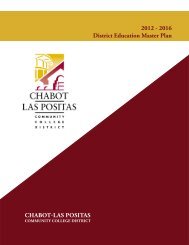City College of San Francisco - California Competes
City College of San Francisco - California Competes
City College of San Francisco - California Competes
You also want an ePaper? Increase the reach of your titles
YUMPU automatically turns print PDFs into web optimized ePapers that Google loves.
THEME II<br />
learning outcomes for all students passing through this course, then the English Department would have<br />
to initiate a comprehensive revision <strong>of</strong> its entire writing and reading sequence. Clearly, the courses that<br />
come before and after English 94 were going to have to be revised based on the changes in this crucial<br />
transitional class that connects basic skills with collegiate and transfer-level writing classes.<br />
Therefore, in Fall 2002, the English Department launched a comprehensive effort to revise all <strong>of</strong> the<br />
courses in the reading and composition sequence. There are eight reading and writing courses below<br />
English 1A. 9 For several <strong>of</strong> these courses, between 30 and 40 sections are <strong>of</strong>fered each semester. Even for a<br />
very large department, this is a daunting task, and everyone involved recognized from the outset that this<br />
would take a number <strong>of</strong> years to complete. Based on the lessons learned from the common exam pilot<br />
projects, the English Department Curriculum Committee charged each <strong>of</strong> the “level workgroups” with<br />
developing specific maps <strong>of</strong> students’ entry characteristics and realistic delineations <strong>of</strong> learning outcomes<br />
that could be effectively accomplished and accurately measured. While there was common agreement<br />
that English 94 required immediate attention, one <strong>of</strong> the challenges the Department faced was the “ripple<br />
effect” that one set <strong>of</strong> outcomes would have on the courses above and below the target class. At the same<br />
time, there was reasonable apprehension among some faculty that this effort to match the skills taught to<br />
the capabilities <strong>of</strong> the students at each level might result in a “dumbing down” <strong>of</strong> the sequence, creating<br />
a gap between the pre-collegiate coursework and the transfer-level classes.<br />
The Department was mindful <strong>of</strong> a lesson <strong>of</strong> the Carnegie retreat: “You start with the test, and work<br />
backwards to what goes on in the classroom.” That is, the process <strong>of</strong> trying to carefully define the outcomes<br />
and conceptualize the assessment <strong>of</strong> those outcomes while simultaneously developing the revised<br />
course outlines provides an interactive dialog that results in improvements in the teaching and learning<br />
process. The leaders <strong>of</strong> these initiatives quickly realized that assessment was going to play a significant<br />
long-term role in both the development <strong>of</strong> these course revisions and the active, ongoing maintenance<br />
<strong>of</strong> the effectiveness <strong>of</strong> the course sequence. However, there still was not broad-based support in the<br />
Department for adopting common assessments across the curriculum. That would take time and evidence<br />
that the common assessments would produce something other than a short-term tool for standardizing<br />
outcomes expectations. The members <strong>of</strong> the department most committed to common assessments also<br />
recognized that assessment would have to be embraced by the faculty working on the courses, not<br />
imposed from the outside by advocates <strong>of</strong> SLOs.<br />
At the time <strong>of</strong> this essay, Spring 2005, the English Department is just a little over two years into this<br />
revision process. English 94 has been revised into a new course, English 93, with much more precisely<br />
defined learning outcomes and with a periodic broad-based common assessment <strong>of</strong> those outcomes<br />
written into the course outline <strong>of</strong> record. The discussion <strong>of</strong> incorporating a learning assessment mechanism<br />
into all <strong>of</strong> the Department’s sequential courses has “come out <strong>of</strong> the closet” and is an active part<br />
<strong>of</strong> the discussions at every level <strong>of</strong> the course revision process.<br />
There are currently two additional pilot projects in the English Department using common assessments<br />
as a tool for evaluating instructional effectiveness. The first involves the lowest level composition course,<br />
English 90. Over the last two years, many <strong>of</strong> the English basic skills faculty have been involved in a project<br />
funded in part by the Koret Foundation designed to integrate the teaching <strong>of</strong> reading with writing by<br />
developing a learning community model that involves students registering for team-taught sections <strong>of</strong><br />
English 90 and its companion reading course, English 9. This project is based on institutional research<br />
that demonstrated that students who had taken both classes concurrently were more likely to succeed<br />
in subsequent English courses.<br />
9 Four are sequential composition classes; two are developmental reading courses that some students must complete prior<br />
to entering the lowest level writing class; two are independent reading classes that students may elect to take based on<br />
placement results.<br />
268 CITY COLLEGE OF SAN FRANCISCO







